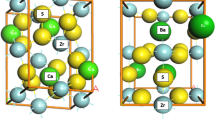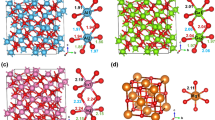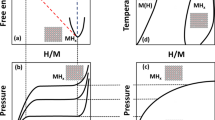Abstract
The nomenclature of phyllosilicates is discussed in relation to structural variations of layers and interlayers. Some discrepancies in the nomenclature which arose due to historical reasons and different viewpoints may be reconciled if the choice of the construction units (layers or their parts) is related to definite sets of structures for which these units are common. Features of idealized models approximating real structures should be considered for classification and derivation of nomenclature sets, whereas priority is given to structural variations before lattice and symmetry characteristics. Layer polymorphs, pseudo-polytypes, polytypes (both simple and complex), and OD structures are distinguished. Particular results obtained for micas as a model example of phyllosilicates in relation to modular structures in general are considered in an Appendix.
Similar content being viewed by others
References
Angel, R.J. (1986) Polytypes and polytypism. Zeitschrift für Kristallographie, 176, 193–204.
Backhaus, K.-O. and Durovic, S. (1984) Polytypism of micas. I. MDO polytypes and their derivation. Clay and Clay Minerals, 32, 453–463.
Bailey, S.W. (chairman) (1977) Report of the IMA-IUCr Joint Committee on nomenclature. Acta Crystallographica, A33, 681–684.
Bailey, S.W. (1980) Summary of recommendations of AIPEA Nomenclature Committee. Clays and Clay Minerals, 28, 73–78.
Brindley, G.W. and Pedro G. (1972) Report of the AIPEA Nomenclature Committee. AIPEA Newsletter, 7, 8–13.
Chukhrov, F.V. and Zvyagin, B.B. (1966) Halloysite, a crystallochemically and mineralogically distinct species. Pp. 11–26 in: Proceedings of the International Clay Conference, 1966, Jerusalem.
Compagnoni, R., Ferraris, G. and Meilini, M. (1985) Carlosturanite, a new asbestiform rock-forming silicate from Val Varatia, Italy. American Mineralogist, 70, 767–772.
Dornberger-Schiff, K. (1964) Grundzüge einer Theorie der OD-Strukturen aus Schichten. Abhandlungen der Deutsches Akademie der Wissenschaften, Berlin, Klass Chemie, 3, 107 pp.
Dornberger-Schiff, K. (1982) Geometrical properties of MDO polytypes and procedures for their derivation. I. General concept and applications to polytype families consisting of OD layers all of the same kind. Acta Crystallographica, A38, 483–491.
Dornberger-Schiff, K. and Durovic, S. (1975) OD interpretation of kaolinite-type structures. I. Symmetry of kaolinite packets and their stacking possibilities. Clays and Clay Minerals, 23, 219–229.
Dornberger-Schiff, K., Backhaus, K.-O. and Durovic, S. (1982) Polytypism of micas: OD-interpretation, stacking symbols, symmetry relations. Clays and Clay Minerals, 30, 364–374.
Durovic, S. (1981) OD-Character, Polytypie und Identifikation von Schichsilikaten. Fortschrifte der Mineralogie, 59, 191–226.
Franzini, M. (1969) The A and B mica layers and the crystal structure of sheet silicates. Contributions Mineralogy and Petrology, 21, 203–224.
Guggenheim, S. (2000) Report of the Association Internationale pour L’Etude des Argilles (AIPEA) Nomenclature Committee for 1999. AIPEA Newsletter, 36, 7–8.
Guinier A. (chairman) (1984) Nomenclature of polytype structures. Report of the IUCr Ad-Hoc Committee on the Nomenclature of Disordered, Modulated and Polytype Structures. Acta Crystallographica, A40, 399–404.
Merlino, S. and Zvyagin, B.B. (in prep.) The pyroxene-spinel polysomatic system.
Nespolo, M. (1999) Analysis of family reflections of OD mica polytypes, and its application to twin identification. Mineralogical Journal (Japan), 21, 53–85.
Ross, M., Takeda, H. and Wones, D.R. (1966) Mica polytypes: systematic description and identification. Science, 151, 191–193.
Takeda, H. and Ross, M. (1995) Mica polytypism: identification and origins. American Mineralogist, 80, 715–724.
Takeda, H. and Sadanaga, R. (1969) New unit layers for micas. Mineralogical Journal (Japan), 5, 434–449.
Thompson, J.B. (1978) Biopyriboles and polysomatic series. American Mineralogist, 63, 239–249.
Tsipursky, S.I. and Drits, V.A. (1984) The distribution of octahedral cations in the 2:1 layers of dioctahedral smectites studied by oblique-texture electron diffraction. Clay Minerals, 19, 177–193.
Zhukhlistov, A.P. and Zvyagin, B.B. (1991) The efficiency of electron diffraction in revealing 2:1 layers, differing in the structure and symmetry, found in dioctahedral micas and smectites. Pp. 1211–1212 in: Proceedings of the 7th EUROCLAY Conference, Dresden, 1991.
Zhukhlistov, A.P., Zvyagin, B.B., Soboleva S.V. and Fedotov, A.F. (1973) The crystal structure of the dioctahedral mica 2M2 determined by high-voltage electron diffraction. Clays and Clay Minerals, 21, 465–470.
Zvyagin, B.B. (1967) Electron-diffraction Analysis of Clay Mineral Structures. Plenum Press, New York, 364 pp.
Zvyagin, B.B. (1993) Modular aspect of crystal structures. Crystallography Reports, 38, 54–60.
Zvyagin, B.B. (1997) Modular Analysis of Crystal Structures. Pp. 345–372 in EMU Notes in Mineralogy, 1 (S. Merlino, editor). Eötvös University Press, Budapest.
Zvyagin, B.B. and Drits, V.A. (1996) Interrelated features of structure and stacking of kaolin mineral layers. Clays and Clay Minerals, 44, 297–303.
Zvyagin, B.B. and Kyazumov, M.G. (1993) Electron diffraction information on the modularity of layer chalcogenide semiconductors (in Russian). Izvestiya Akademii Nauk (series physics), 57, 22–29.
Zvyagin, B.B. and Zhukhlistov, A.P. (1999) Nomenclature systematics of micas and its display by texture electron diffraction. Abstracts, EUROCLAY’99, Krakow, Poland, p. 150.
Zvyagin, B.B., Vrublevskaya, Z.V., Zhukhlistov, A.P., Sidorenko, O.V., Soboleva, S.V. and Fedotov, A.F. (1979) High voltage electron diffraction in the study of layered minerals (in Russian). Nauka, Moscow, 224 pp.
Zvyagin, B.B., Rabotnov, V.T., Sidorenko, O.V. and Kotelnikov, D.D. (1985) The unique mica composed of non-centrosymetric layers (in Russian). Izvestiya Akademii Nauk (series geology), 5, 121–124.
Author information
Authors and Affiliations
Corresponding author
Additional information
This paper is based on the presentation by B. B. Zvyagin during the award of the 2000 Marilyn and Sturgess W. Bailey Distinguished Member Award of the Clay Minerals Society.
Rights and permissions
About this article
Cite this article
Zvyagin, B.B. Current problems with the nomenclature of phyllosilicates. Clays Clay Miner. 49, 492–499 (2001). https://doi.org/10.1346/CCMN.2001.0490602
Received:
Revised:
Published:
Issue Date:
DOI: https://doi.org/10.1346/CCMN.2001.0490602




